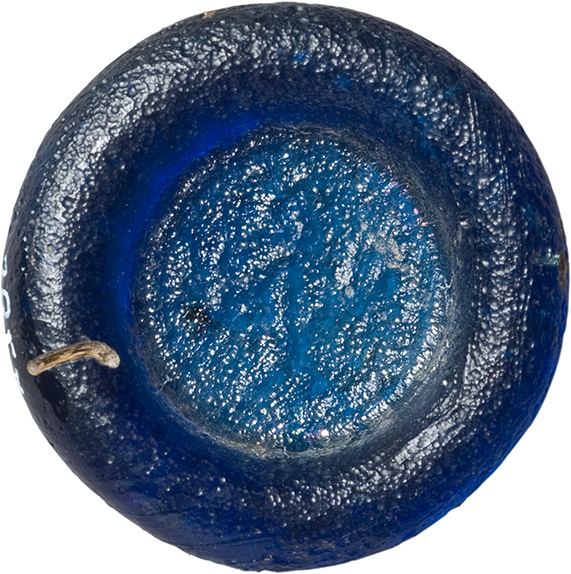
-
Copyright credit: Anatolian Weights and Measures Collection. Courtesy of Suna and İnan Kıraç Foundation Pera Museum / Bendeguz Tobias

ARCHAEOLOGICAL DESCRIPTION OF THE WEIGHT
Authority
Mint
Denomination
Material
Glass
Manufacture
Cast
Shape
Disc or similar (ellipse, etc.)
Length
2.40 cm
Width
2.40 cm
Height
0.50 cm
Metrology
| Mass (g) | Mass (grain) | Date of measurement | Reference | fragmented | cleaned | reference weight |
|---|---|---|---|---|---|---|
| 3.25 | - | - | (scientific literature) | No | No | Yes |
Iconography
| Symbol | Technique | Direction | Position | Number | Synecdoche |
|---|
Wear
Corrosion
Handle
No
Suspension hole
No
Recarved mould
No
Recarved weight
No
Intentionally destroyed
No
Archaeological description
Glass weight. Disc. Colour (Farbe): dunkelblau. Iconography: No cross. No wreath.
CPAI III/2: Middle of the 7th century AD? Eastern Mediterranean. Weight for a gold coin (solidus/20 carat). Glass, 24 x 5 mm; 3.25 g. Inv. no. PMA 2857. Acquired in 2007. Description: Dark-blue coloured, transparent round weight with a central weathered impression. Within a circle, a hardly visible monogram is likely composed of the letters NE in ligature on the left, Λ at the bottom, P on the right, Φ in the centre, and T and the ligature at the top. The monogram has been resolved by John Nesbitt as ΦΛOPETIN or ΦΛOPENTIN, although the name is actually written with an omega and not an omicron. Therefore, the resolution is questionable. The other weights with this type of monogram are made of a yellow or pale green glass. A light-weight solidus of 20 carat with an actual mass of about 3.25 g is known from the time of Constans II.
CPAI III/2: Middle of the 7th century AD? Eastern Mediterranean. Weight for a gold coin (solidus/20 carat). Glass, 24 x 5 mm; 3.25 g. Inv. no. PMA 2857. Acquired in 2007. Description: Dark-blue coloured, transparent round weight with a central weathered impression. Within a circle, a hardly visible monogram is likely composed of the letters NE in ligature on the left, Λ at the bottom, P on the right, Φ in the centre, and T and the ligature at the top. The monogram has been resolved by John Nesbitt as ΦΛOPETIN or ΦΛOPENTIN, although the name is actually written with an omega and not an omicron. Therefore, the resolution is questionable. The other weights with this type of monogram are made of a yellow or pale green glass. A light-weight solidus of 20 carat with an actual mass of about 3.25 g is known from the time of Constans II.
Autopsy
No
INSCRIPTION
| Language | Technique | Legend type |
|---|
Fac simile
Edition
{monogramma}
Monogram
Unknown-29
ARCHAEOLOGICAL CONTEXT
Findspot (region)
Findspot (site)
context
CIRCUMSTANCES OF ACQUISITION
Region
City
Date of first acquisition
circumstances
DATING OF THE WEIGHT
Curatorial Section
LATE ROMAN AND BYZANTINE
Time frame
Comments on Chronology
COLLECTION HISTORY
Collection
| Name | Date of acquisition | Inventory number |
|---|---|---|
| Pera Museum (Istanbul) | None | PMA 2857 |
Bibliography
| Reference | Page/Column | Reference (number) | Plate / Figure | Comment |
|---|---|---|---|---|
| CPAI III/2 | None | 740 | pl. 199 | None |
VARIA
Additional comment
2007 erworben.
CPAI III/2: Ref.: Perassi 2002: 456-458; 473 fig. 6; 474 fig. 7a-b; Monneret Villard 1922: 104 no. H33c; Frohner 1879: pl. 11 no. 64; Markoff 1910: 641 no. 22-23; pl. 31; Adelson 1957: 170 no. 167.
CPAI III/2: Ref.: Perassi 2002: 456-458; 473 fig. 6; 474 fig. 7a-b; Monneret Villard 1922: 104 no. H33c; Frohner 1879: pl. 11 no. 64; Markoff 1910: 641 no. 22-23; pl. 31; Adelson 1957: 170 no. 167.
Permalink
External link